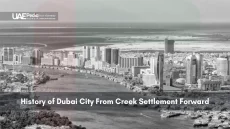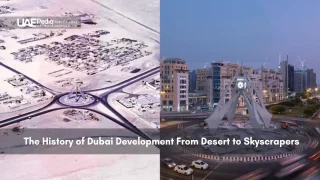Have you ever wondered about the hidden gems beneath the sands of the United Arab Emirates? The Persian Gulf region, nestled in the heart of the Arabian Peninsula, holds secrets that span millennia. From prehistoric settlements to bustling Bronze Age trade hubs, the UAE’s archaeological sites paint a vivid picture of human history in West Asia. Ready to embark on a journey through time in this Middle Eastern marvel?
Imagine holding 200,000 years of history in your hands. That’s exactly what the new coffee table book “Mleiha: Ancient Treasures of the UAE” offers. Released in November 2024, this 200-page hardcover tome showcases the archaeological wonders of Mleiha. A region that’s earned a spot on UNESCO’s tentative list of World Heritage Sites.
But the story doesn’t end there. Recent discoveries on Al Sinniyah Island have unearthed ancient settlements. They are potentially linked to the fabled lost city of Tawam. This adds another layer to the Emirates’ rich tapestry of history.
UAE Archaeological Sites: From Ancient Settlements to Modern Discoveries
The United Arab Emirates has many archaeological sites. They show us its ancient past. These sites cover different times, from old settlements to Islamic villages. Excavations have found important things, showing the UAE’s rich culture.
Mleiha Archaeological Centre and Early Human Settlement
Mleiha Archaeological Centre in Sharjah shows early human life in the UAE. Finds here go back to 130,000-120,000 BCE. This links to the move of modern humans from Africa.
The center has graves from the Neolithic and Umm Al Nar times. It also has a fortified area from the Hellenistic era.
Ed-Dur: The Lost City of Arabia
Ed-Dur in Umm Al Qawain is a big archaeological site in the UAE. It covers many times, like the Ubaid and Stone Age. It also includes the Bronze, Iron, and Pre-Islamic eras.
At Ed-Dur, archaeologists found thousands of stone tombs. They also found signs of trade. This shows it was a key place in history.
Jebel Buhais Necropolis
Jebel Buhais is near Madam in Sharjah. It’s the oldest inland burial site in the UAE. It goes back to the 5th millennium BCE.
The site tells us about ancient burial ways and social life. It helps us understand the UAE’s past better.
| Archaeological Site | Location | Time Period | Key Features |
|---|---|---|---|
| Mleiha Archaeological Centre | Sharjah | 130,000 BCE – Hellenistic Era | Early human settlement, Neolithic and Umm Al Nar burials |
| Ed-Dur | Umm Al Qawain | Ubaid – Pre-Islamic Era | Coastal settlement, stone-built tombs, trade evidence |
| Jebel Buhais | Sharjah | 5th millennium BCE onwards | Oldest inland burial site, diverse necropolis |
The Bronze Age Legacy of the Emirates

The UAE has a long history, with the Bronze Age playing a big role. We’ve learned a lot about early settlements and trade from ancient burial sites and digs.
Hafit Period and Beehive Tombs
The Hafit period was from 3,200 to 2,600 BCE. It brought beehive tombs to the UAE and Oman. These tombs, found near Jebel Hafit in Al Ain, tell us about early Bronze Age people and their burial ways.
Umm Al Nar Culture and Trade
The Umm Al Nar culture lasted from 2,700 to 2,000 BCE. It was named after an island where important finds were made. This time saw big trade growth and advanced burial customs, showing the area’s rising importance.
Evidence of Early Maritime Commerce
Recent digs in the UAE have found proof of Bronze Age sea trade. They found pottery, copper, and bitumen for boats. This shows trade with Mesopotamia and the Indus Valley.
| Archaeological Site | Key Discoveries | Age |
|---|---|---|
| Sas Al Nakhl Island | 30,000 bones, imported pottery, bitumen | 2800-2200 BC |
| Ghagha Island | Ancient structures | 8,500 years old |
| Delma Island | Early settlement | 7,000 years old |
These finds show the UAE’s key role in ancient trade. They also hint at more UNESCO sites to come. Ongoing digs keep revealing the UAE’s Bronze Age past, helping us understand its modern roots.
Archaeological Excavations on Sas Al Nakhl Island
UAE archaeological research has found exciting things about the Bronze Age on Sas Al Nakhl Island. Recent digs have brought up many artifacts and insights into ancient sea travel.
Recent Discoveries and Artifacts
Archaeologists found over 30,000 bone pieces on Sas Al Nakhl Island. These bones show what people ate back then, like fish and seabirds. The island also had stone tools, beads, and fishhooks.
International Trade Connections
Excavations showed pottery from Mesopotamia and the Indus Valley. This proves Sas Al Nakhl was part of long-distance trade. The use of Mesopotamian bitumen for waterproofing shows they were skilled sailors.
Ancient Maritime Activities
Sas Al Nakhl was a key port from 2800 to 2200 BC. It traded with distant places and had impressive tombs. Its location made it a center for ancient sea trade.
| Time Period | Key Findings | Significance |
|---|---|---|
| 2800-2200 BC | Pottery, stone tools, bitumen | Evidence of trade and seafaring |
| Bronze Age | 30,000+ bone fragments | Insights into ancient diet |
| 1959 | First UAE excavations | Discovery of Umm an-Nar culture |
These discoveries show how vital UAE ancient museums are. They help us learn about the Bronze Age. Restoration work at UAE archaeological sites keeps revealing more of the region’s history.
Preservation and Modern Archaeological Research
The UAE is very proud of its ancient history. It has over 17 important sites in Dubai, covering more than 300,000 years. The Department of Culture and Tourism – Abu Dhabi (DCT Abu Dhabi) works hard to find and save these treasures.
DCT Abu Dhabi’s Archaeological Program
DCT Abu Dhabi follows Sheikh Zayed’s path, digging at seven sites in Abu Dhabi. They’ve found amazing things, like at Saruq al-Hadid, from 2600-550 BC. These finds show the area’s old trade and culture.
UNESCO World Heritage Sites
The UAE has many UNESCO World Heritage Sites, like those in Al Ain. Places like the Al Bidya Mosque in Fujairah show the UAE’s dedication to keeping its history alive. More and more people can see these sites, getting a peek into the past.
Museum Development and Public Access
UAE’s museums are key for learning and saving history. New museums like the Delma Island Museum and a visitor center on Sir Bani Yas Island are opening. Soon, the Zayed National Museum will show finds from Umm an-Nar and other key sites. By 2025, museums like the Natural History Museum Abu Dhabi and Guggenheim Abu Dhabi will add more to the cultural scene.
By working together, like Dubai Culture and DCT Abu Dhabi, the UAE wants to share its heritage with the world. They’re organizing training, workshops, and research to teach about archaeological sites. This helps build a strong UAE identity.
Archaeology plays a huge role in understanding UAE history. Sites like Hili Archaeological Park and Saruq Al-Hadid show us the past. The Hili Grand Tomb, from 2000 BCE, shows early architectural skills.
Early settlers were smart to farm in the desert 5000 years ago. This shows their ability to adapt to tough conditions.
UAE heritage sites give us interesting clues. A craftsman’s fingerprints at Hili in 2019 add a personal touch. At Saruq Al-Hadid, 123 artifacts tell us about life and trade back then.
These finds show the UAE was a crossroads of cultures. They paint a detailed picture of the past.
Preserving UAE’s past is a big challenge. But, new methods are being used to protect these sites. Dubai Culture is working hard to share UAE’s history with the world.
As we keep studying, we’ll learn more about the Emirates’ heritage. These sites hold many secrets waiting to be uncovered.



















